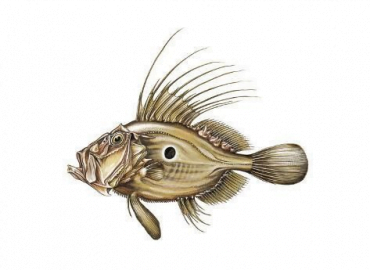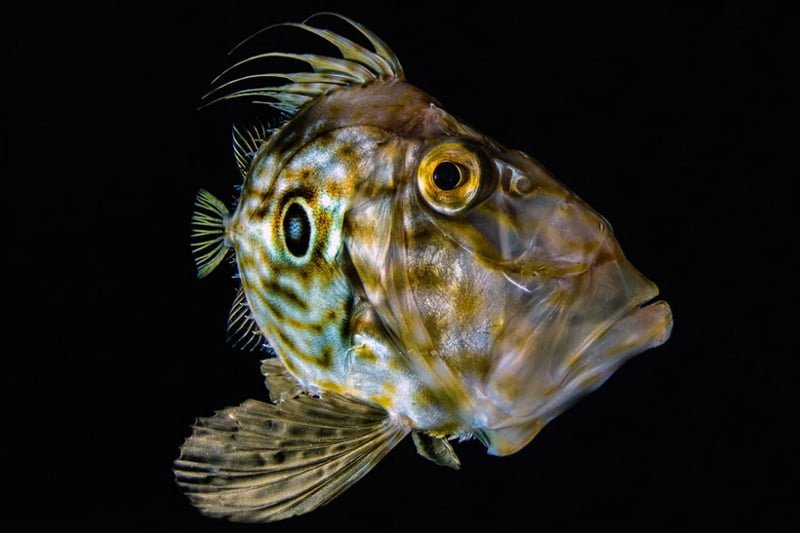Zeus Faber
– John Dory –

| Conservation status |
|---|
 Data Deficient (IUCN 3.1)[2] |
| Scientific classification |
Zeus faber
Linnaeus, 1758
| Kingdom: | Animalia |
| Phylum: | Chordata |
| Class: | Actinopterygii |
| Order: | Zeiformes |
| Family: | Zeidae |
| Genus: | Zeus |
| Species: | Z. faber |


John Dory, St Pierre or Peter’s Fish, refers to fish of the genus Zeus, especially Zeus faber, of widespread distribution. It is an edible demersal coastal marine fish with a laterally compressed olive-yellow body which has a large dark spot, and long spines on the dorsal fin. The dark spot is used to flash an ‘evil eye’ if danger approaches. Its large eyes at the front of the head provide it with binocular vision and depth perception, which are important for predators. The John Dory’s eye spot on the side of its body also confuses prey, which are scooped up in its big mouth.[3][4]
In New Zealand, Māori know it as kuparu, and on the East Coast of the North Island, they gave some to Captain James Cook on his first voyage to New Zealand in 1769. Several casks of them were pickled.[3]
Description
The John Dory grows to a maximum size of 65 cm (2 ft) and 5 kg (12 lb) in weight. It has 10 long spines on its dorsal fin and 4 spines on its anal fin. It has microscopic, sharp scales that run around the body. The fish is an olive green color with a silver white belly and has a dark spot on its side. Its eyes are near the top of its head. It has a flat, round body shape and is a poor swimmer.
The John Dory has a high laterally compressed body – its body is so thin it can hardly be seen from the front. The large eyes at the front of the head provide it with the binocular vision and depth perception it needs to catch prey. It has a large dark spot on both sides which it uses to flash an “evil eye” if danger approaches. This eye spot also confuses prey, which can then be sucked into its mouth.[7]
Distribuition
John Dory are benthopelagic coastal fish, found on the coasts of Africa, South East Asia, New Zealand, Australia, the coasts of Japan, and on the coasts of Europe.
Biotope
Adult individuals are solitary. On the other hand, we can meet small groups of juveniles.
This animal frequents coastal waters. Although occasionally present on shallow rocky bottoms (5 m), it most often evolves at substantial depths (30-400 m).
Etymology
Various, often doubtful explanations are given of the origin of the name. It may be an arbitrary or jocular variation of dory (from French dorée, gilded), or an allusion to John Dory, the hero of an old ballad. Others suggest that “John” derives from the French jaune, yellow. The novel An Antarctic Mystery by Jules Verne gives another account, which has some popularity but is probably fanciful: “The legendary etymology of this piscatorial designation is Janitore, the ‘door-keeper,’ in allusion to St. Peter, who brought a fish said to be of that species, to Jesus at his command.” Other known names for the John Dory are the “St. Pierre”, or “Peter’s Fish”, perhaps explaining why dories were often referred to as “Peter Boats”, Saint Peter being the patron saint of fishermen.[5] A related legend says that the dark spot on the fish’s flank is St. Peter’s thumbprint.[6] In the north coast of Spain, it is known commonly as San Martiño.
Alimentation
The Zeus faber is a predator. It often remains motionless, slowly approaches the preys on which it feeds (fish, cuttlefish, shrimp, etc.) and grabs them with its protractile mouth when they pass nearby.
The John Dory catches prey by stalking it, then extending its jaw forward in a tube-like structure to suck the fish in with some water. The water then flows out through the gills; the pre-maxillary bone, the only tooth-bearing bone in this fish, is used to grind the food.
Its primarily eats smaller fish, especially schooling fish such as sardines. Occasionally it eats squid and cuttlefish.
Its main predators are sharks such as the dusky shark, and large bony fish.
Reproduction and Lifespan
This fish is sex-separated. When John Dories are 3 or 4 years of age, they are ready to reproduce. It spawns in spring at great depth in the Mediterranean, and in summer in the northeast Atlantic.. They are substrate scatterers, which means that they release sperm and eggs into the water to fertilize. The eggs resulting from fertilization are small (about 2 mm) and planktonic, rarely seen in diving.
Typical lifespan is about 12 years in the wild.
As Food
The cookery writer Eliza Acton observes in her 1845 book, Modern Cookery for Private Families, that John Dory “though of uninviting appearance, is considered by some person(s) as the most delicious fish that appears at [the] table”. She recommends simply baking it “very gently”, avoiding drying it out in the oven.[8]
Similar Species
In the tropical Atlantic, there is a close species: the silver scallop ( Zenopsis conchifer , Lowe, 1852), whose muzzle is located much higher.
Associated Life
On the Saint-Pierre, we can sometimes observe parasitic copepods. The two long filaments correspond to the ovigerous sacs of the female, which can reach 4-5 cm in length (the rest of the body is just under 1 cm). The most common parasite and almost present in France on the skin of every Zeus faber is Caligus zei .
Other species of parasites have also been found (more rarely) in this fish: Chondroclasts zei (parasitic copepod on the gills), Lepeophtheirus pectoralis (ectoparasitic copepod * on around twenty species of marine fish), Peniculus fistula (Pennelliid copepod ectoparasites other species of marine fish with very elongated bodies) andFistulicola plicatus (endoparasitic plathelminth *).
Further Information
This species is rarely seen by divers, although it is easy to approach.
Its flesh being appreciated, the Saint-Pierre is the subject of a regular fishing. Its weight can reach about eight kilograms.




















































































































































































































































































































































































